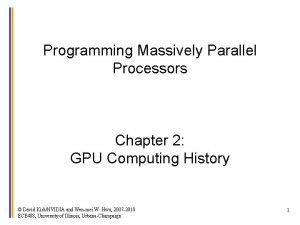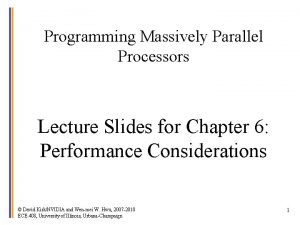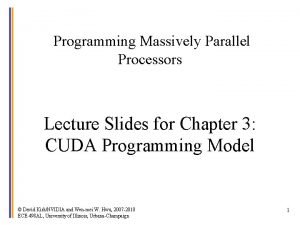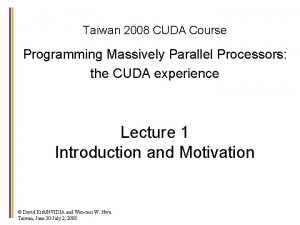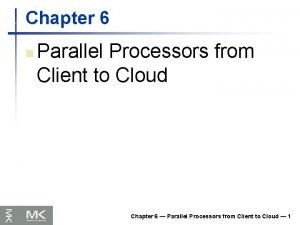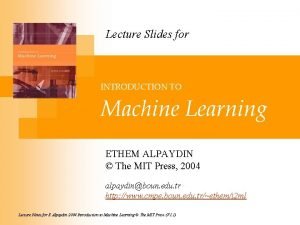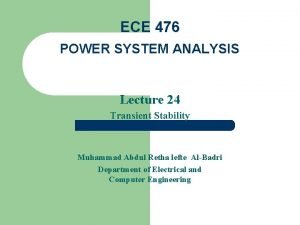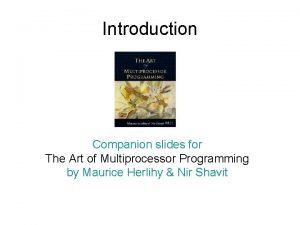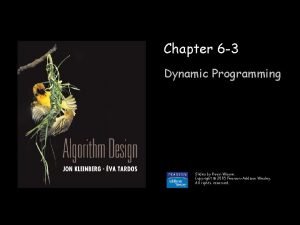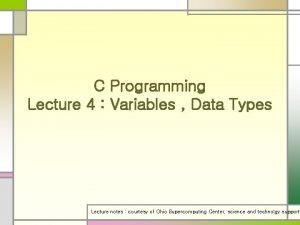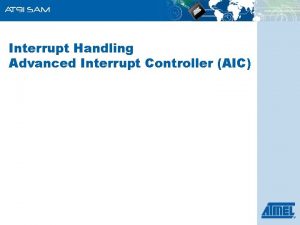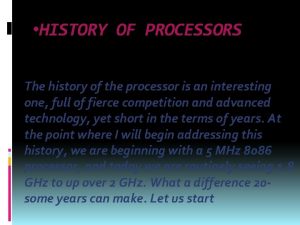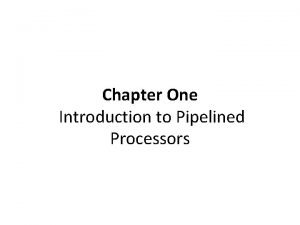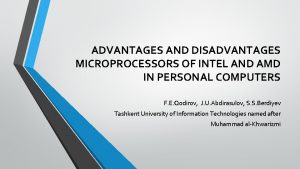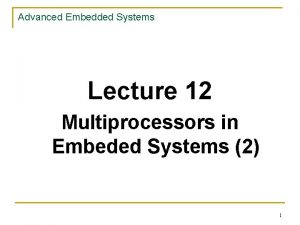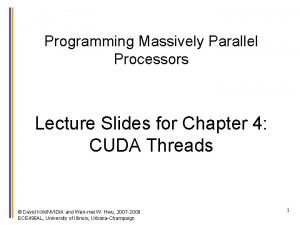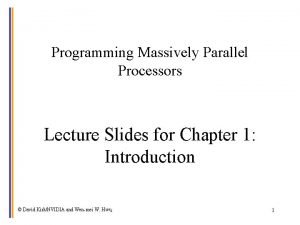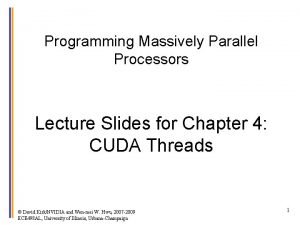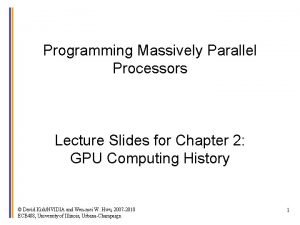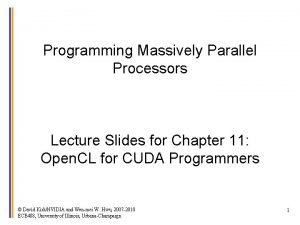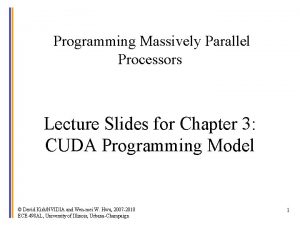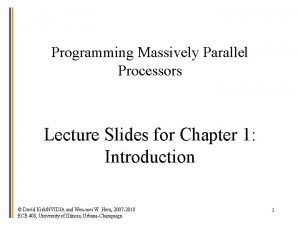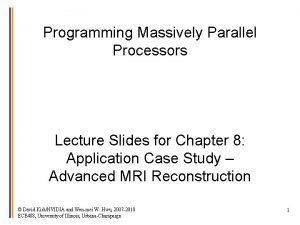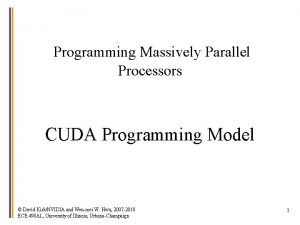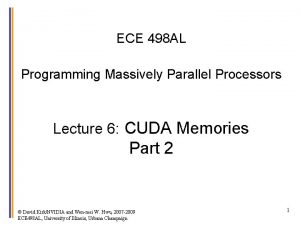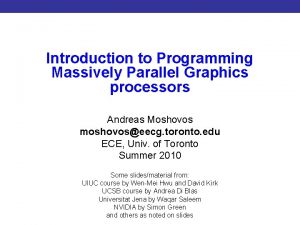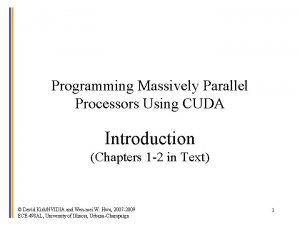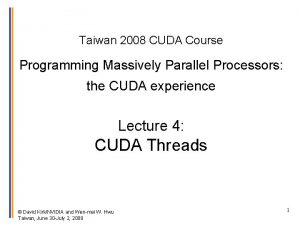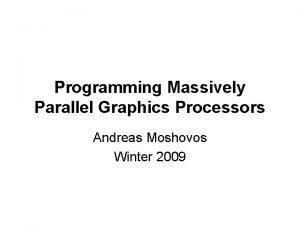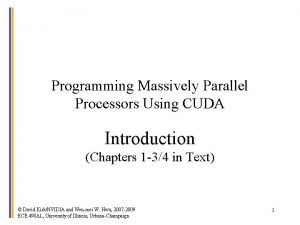Programming Massively Parallel Processors Lecture Slides for Chapter





















- Slides: 21

Programming Massively Parallel Processors Lecture Slides for Chapter 4: CUDA Threads © David Kirk/NVIDIA and Wen-mei W. Hwu, 2007 -2009 ECE 498 AL, University of Illinois, Urbana-Champaign 1

Block IDs and Thread IDs • Each thread uses IDs to decide what data to work on – Block ID: 1 D or 2 D – Thread ID: 1 D, 2 D, or 3 D • Simplifies memory addressing when processing multidimensional data – Image processing – Solving PDEs on volumes – … © David Kirk/NVIDIA and Wen-mei W. Hwu, 2007 -2009 ECE 498 AL, University of Illinois, Urbana-Champaign 2

bx Matrix Multiplication Using Multiple Blocks 0 1 2 tx 0 1 2 TILE_WIDTH-1 Nd WIDTH • Break-up Pd into tiles • Each block calculates one tile – Each thread calculates one element – Block size equal tile size Md Pd 1 ty Pdsub TILE_WIDTH-1 WIDTH by 0 1 2 TILE_WIDTHE 0 TILE_WIDTH 2 © David Kirk/NVIDIA and Wen-mei W. Hwu, 2007 -2009 ECE 498 AL, University of Illinois, Urbana-Champaign WIDTH 3

A Small Example Block(0, 0) Block(1, 0) P 0, 0 P 1, 0 P 2, 0 P 3, 0 TILE_WIDTH = 2 P 0, 1 P 1, 1 P 2, 1 P 3, 1 P 0, 2 P 1, 2 P 2, 2 P 3, 2 P 0, 3 P 1, 3 P 2, 3 P 3, 3 Block(0, 1) © David Kirk/NVIDIA and Wen-mei W. Hwu, 2007 -2009 ECE 498 AL, University of Illinois, Urbana-Champaign Block(1, 1) 4

A Small Example: Multiplication Nd 0, 0 Nd 1, 0 Nd 0, 1 Nd 1, 1 Nd 0, 2 Nd 1, 2 Nd 0, 3 Nd 1, 3 Md 0, 0 Md 1, 0 Md 2, 0 Md 3, 0 Pd 0, 0 Pd 1, 0 Pd 2, 0 Pd 3, 0 Md 0, 1 Md 1, 1 Md 2, 1 Md 3, 1 Pd 0, 1 Pd 1, 1 Pd 2, 1 Pd 3, 1 Pd 0, 2 Pd 1, 2 Pd 2, 2 Pd 3, 2 Pd 0, 3 Pd 1, 3 Pd 2, 3 Pd 3, 3 © David Kirk/NVIDIA and Wen-mei W. Hwu, 2007 -2009 ECE 498 AL, University of Illinois, Urbana-Champaign 5

Revised Matrix Multiplication Kernel using Multiple Blocks __global__ void Matrix. Mul. Kernel(float* Md, float* Nd, float* Pd, int Width) { // Calculate the row index of the Pd element and M int Row = block. Idx. y*TILE_WIDTH + thread. Idx. y; // Calculate the column idenx of Pd and N int Col = block. Idx. x*TILE_WIDTH + thread. Idx. x; float Pvalue = 0; // each thread computes one element of the block sub-matrix for (int k = 0; k < Width; ++k) Pvalue += Md[Row*Width+k] * Nd[k*Width+Col]; Pd[Row*Width+Col] = Pvalue; } © David Kirk/NVIDIA and Wen-mei W. Hwu, 2007 -2009 ECE 498 AL, University of Illinois, Urbana-Champaign 6

Revised Step 5: Kernel Invocation (Host-side Code) // Setup the execution configuration dim 3 dim. Grid(Width/TILE_WIDTH, Width/TILE_WIDTH); dim 3 dim. Block(TILE_WIDTH, TILE_WIDTH); // Launch the device computation threads! Matrix. Mul. Kernel<<<dim. Grid, dim. Block>>>(Md, Nd, Pd, Width); © David Kirk/NVIDIA and Wen-mei W. Hwu, 2007 -2009 ECE 498 AL, University of Illinois, Urbana-Champaign 7

CUDA Thread Block • • All threads in a block execute the same kernel program (SPMD) Programmer declares block: – – – • • Thread Id #: 0123… m Threads have thread id numbers within block – • Block size 1 to 512 concurrent threads Block shape 1 D, 2 D, or 3 D Block dimensions in threads CUDA Thread Block Thread program uses thread id to select work and address shared data Threads in the same block share data and synchronize while doing their share of the work Threads in different blocks cannot cooperate – Each block can execute in any order relative to other blocs! © David Kirk/NVIDIA and Wen-mei W. Hwu, 2007 -2009 ECE 498 AL, University of Illinois, Urbana-Champaign Thread program Courtesy: John Nickolls, NVIDIA 8

Transparent Scalability • Hardware is free to assigns blocks to any processor at any time – A kernel scales across any number of parallel processors Kernel grid Device Block 0 Block 1 Block 2 Block 3 Block 0 Block 1 Block 4 Block 5 Block 6 Block 7 Block 2 Block 3 Block 4 Block 5 Block 6 Block 7 time Block 0 Block 1 Block 2 Block 3 Block 4 Block 5 Block 6 Block 7 Each block can execute in any order relative to other blocks. © David Kirk/NVIDIA and Wen-mei W. Hwu, 2007 -2009 ECE 498 AL, University of Illinois, Urbana-Champaign 9

G 80 CUDA mode – A Review • Processors execute computing threads • New operating mode/HW interface for computing Host Input Assembler Thread Execution Manager Parallel Data Cache Parallel Data Cache Texture Texture Texture Load/store Global Memory © David Kirk/NVIDIA and Wen-mei W. Hwu, 2007 -2009 ECE 498 AL, University of Illinois, Urbana-Champaign Load/store 10

G 80 Example: Executing Thread Blocks t 0 t 1 t 2 … tm SM 0 SM 1 MT IU SP t 0 t 1 t 2 … tm MT IU Blocks SP • Blocks Shared Memory Threads are assigned to Streaming Multiprocessors in block granularity – Up to 8 blocks to each SM as resource allows – SM in G 80 can take up to 768 threads Shared Memory • • • © David Kirk/NVIDIA and Wen-mei W. Hwu, 2007 -2009 ECE 498 AL, University of Illinois, Urbana-Champaign Could be 256 (threads/block) * 3 blocks Or 128 (threads/block) * 6 blocks, etc. Threads run concurrently – SM maintains thread/block id #s – SM manages/schedules thread execution 11

G 80 Example: Thread Scheduling • Each Block is executed as 32 thread Warps – – • An implementation decision, not part of the CUDA programming model Warps are scheduling units in SM If 3 blocks are assigned to an SM and each block has 256 threads, how many Warps are there in an SM? – – Each Block is divided into 256/32 = 8 Warps There are 8 * 3 = 24 Warps © David Kirk/NVIDIA and Wen-mei W. Hwu, 2007 -2009 ECE 498 AL, University of Illinois, Urbana-Champaign Block 1 Warps … t 0 t 1 t 2 … t 31 … …Block 2 Warps t 0 t 1 t 2 … t 31 … Block 1 Warps … t 0 t 1 t 2 … t 31 … Streaming Multiprocessor Instruction L 1 Instruction Fetch/Dispatch Shared Memory SP SP SFU SP SP 12

G 80 Example: Thread Scheduling (Cont. ) • SM implements zero-overhead warp scheduling – Warps whose next instruction has its operands ready for consumption are eligible for execution – Eligible Warps are selected for execution on a prioritized scheduling policy – All threads in a warp execute the same instruction when selected © David Kirk/NVIDIA and Wen-mei W. Hwu, 2007 -2009 ECE 498 AL, University of Illinois, Urbana-Champaign 13

G 80 Block Granularity Considerations • For Matrix Multiplication using multiple blocks, should I use 8 X 8, 16 X 16 or 32 X 32 blocks? – For 8 X 8, we have 64 threads per Block. Since each SM can take up to 768 threads, there are 12 Blocks. However, each SM can only take up to 8 Blocks, only 512 threads will go into each SM! – For 16 X 16, we have 256 threads per Block. Since each SM can take up to 768 threads, it can take up to 3 Blocks and achieve full capacity unless other resource considerations overrule. – For 32 X 32, we have 1024 threads per Block. Not even one can fit into an SM! © David Kirk/NVIDIA and Wen-mei W. Hwu, 2007 -2009 ECE 498 AL, University of Illinois, Urbana-Champaign 14

More Details of API Features © David Kirk/NVIDIA and Wen-mei W. Hwu, 2007 -2009 ECE 498 AL, University of Illinois, Urbana-Champaign 15

Application Programming Interface • The API is an extension to the C programming language • It consists of: – Language extensions • To target portions of the code for execution on the device – A runtime library split into: • A common component providing built-in vector types and a subset of the C runtime library in both host and device codes • A host component to control and access one or more devices from the host • A device component providing device-specific functions © David Kirk/NVIDIA and Wen-mei W. Hwu, 2007 -2009 ECE 498 AL, University of Illinois, Urbana-Champaign 16

Language Extensions: Built-in Variables • dim 3 grid. Dim; – Dimensions of the grid in blocks (grid. Dim. z unused) • dim 3 block. Dim; – Dimensions of the block in threads • dim 3 block. Idx; – Block index within the grid • dim 3 thread. Idx; – Thread index within the block © David Kirk/NVIDIA and Wen-mei W. Hwu, 2007 -2009 ECE 498 AL, University of Illinois, Urbana-Champaign 17

Common Runtime Component: Mathematical Functions • • pow, sqrt, cbrt, hypot exp, exp 2, expm 1 log, log 2, log 10, log 1 p sin, cos, tan, asin, acos, atan 2 sinh, cosh, tanh, asinh, acosh, atanh ceil, floor, trunc, round Etc. – When executed on the host, a given function uses the C runtime implementation if available – These functions are only supported for scalar types, not vector types © David Kirk/NVIDIA and Wen-mei W. Hwu, 2007 -2009 ECE 498 AL, University of Illinois, Urbana-Champaign 18

Device Runtime Component: Mathematical Functions • Some mathematical functions (e. g. sin(x)) have a less accurate, but faster device-only version (e. g. __sin(x)) – – __pow __log, __log 2, __log 10 __exp __sin, __cos, __tan © David Kirk/NVIDIA and Wen-mei W. Hwu, 2007 -2009 ECE 498 AL, University of Illinois, Urbana-Champaign 19

Host Runtime Component • Provides functions to deal with: – Device management (including multi-device systems) – Memory management – Error handling • Initializes the first time a runtime function is called • A host thread can invoke device code on only one device – Multiple host threads required to run on multiple devices © David Kirk/NVIDIA and Wen-mei W. Hwu, 2007 -2009 ECE 498 AL, University of Illinois, Urbana-Champaign 20

Device Runtime Component: Synchronization Function • void __syncthreads(); • Synchronizes all threads in a block • Once all threads have reached this point, execution resumes normally • Used to avoid RAW / WAR / WAW hazards when accessing shared or global memory • Allowed in conditional constructs only if the conditional is uniform across the entire thread block © David Kirk/NVIDIA and Wen-mei W. Hwu, 2007 -2009 ECE 498 AL, University of Illinois, Urbana-Champaign 21
 Programming massively parallel processors
Programming massively parallel processors Programming massively parallel processors
Programming massively parallel processors Programming massively parallel processors
Programming massively parallel processors Programming massively parallel processors, kirk et al.
Programming massively parallel processors, kirk et al. Parallel processors from client to cloud
Parallel processors from client to cloud A small child slides down the four frictionless slides
A small child slides down the four frictionless slides Force and work relationship quick check
Force and work relationship quick check Principles of economics powerpoint lecture slides
Principles of economics powerpoint lecture slides Machine learning lecture
Machine learning lecture Business communication lecture slides
Business communication lecture slides 01:640:244 lecture notes - lecture 15: plat, idah, farad
01:640:244 lecture notes - lecture 15: plat, idah, farad Art of multiprocessor programming slides
Art of multiprocessor programming slides Dynamic programming slides
Dynamic programming slides C data types with examples
C data types with examples Linear pipeline vs non linear pipeline
Linear pipeline vs non linear pipeline Aicarm
Aicarm The history of cpu
The history of cpu Unifunction and multifunction pipeline
Unifunction and multifunction pipeline Digital camera processors
Digital camera processors Advantages of intel processor
Advantages of intel processor Embeded processors
Embeded processors Embedded innovator winter 2010
Embedded innovator winter 2010
